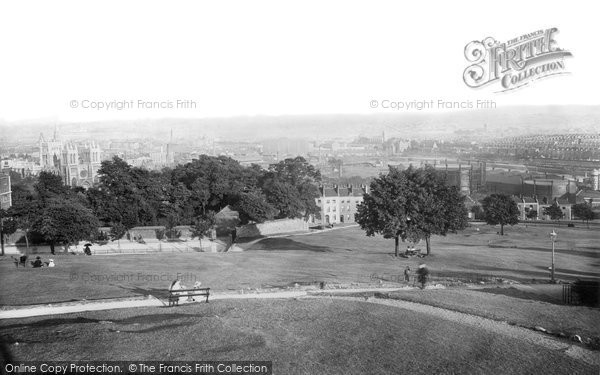Tales Of Brandon Hill
A Memory of Bristol.
Queen Elizabeth I granted housewives the right to dry their washing on Bristol's Brandon Hill.
Bristol's most prominent land mark, the Cabot Tower, was 100 years old in 1998. But the official opening was marked by a disastrous fire, a confidence trick and some rather clever council penny pinching. The foundation stone of the Cabot Tower was laid on Brandon Hill in 1897, the 400th anniversary of John Cabot's journey to the New World. It was supposed to simply commemorate the "Matthew's" journey, until someone on the council came up with a great idea to help raise the cash. Money for the tower had to be found from public subscriptions, and the promoters encouraged wider interest with a neat bit of marketing. They pointed out that it was also Queen Victoria's Diamond Jubilee Year, so the tower could double up as a memorial to "the 60th year of Her Majesty's glorious reign". Clever stuff; it raised 5,000.
By July 1898, the 75ft tower (105ft to the top of the spire) had been completed at a cost of 3,250, but it was decided to defer the formal opening until September when the British Association was meeting in the city. All was ready for the biggest party of the year, when disaster struck.
The celebrations were due to be held in the Colston Hall, but on the night of September 1, the building was gutted by fire and the banquet was hurriedly moved to Bristol Grammar School's great hall.
The tower was officially opened by the Marquis of Dufferin and Ava, former governor-general of Canada, in the presence of Canadian and American representatives and most of the local bigwigs. A huge crowd turned out, although whether they would have heard the many speeches in the days before public address systems is doubtful.
Then the VIPs headed off for their party, leaving the general populace to marvel at Bristol's latest wonder.
It was at the banquet that Lord Dufferin thanked God that Cabot had got to America first (which, of course, he didn't), thus ensuring that the continent became a bastion of the Anglo Saxon race instead of being occupied by "an alien people" - ie the Spanish and Portuguese.
It was also there that Louis de Rougemont made a small piece of history. De Rougemont claimed to be a Frenchman who had just returned from living for 28 years among the aborigines of Australia. He gave a graphic account of his adventures to spellbound banquet-goers and even read a much-appreciated paper to the British Association meeting. Red faces all round, then, when it was discovered that his name wasn't de Rougemont at all and that he had made up the whole remarkable tale.
The tower itself was designed by W V Gough in what is called a Tudor Gothic style, and the spire is topped by a gilded figure representing commerce mounted on a globe. But it could have been a statue of John and Sebastian Cabot instead, and sited on the Downs.
There was quite a debate in the Bristol newspapers 100 years ago over the design of a monument to mark the 400th anniversary of Cabot's historic voyage from Bristol. One John Fisher came up with a plan for a statue of John Cabot, peering earnestly ahead at the coast of America with his teenage son Sebastian there at his side. Fisher went as far as modelling his idea in clay and suggested that it should be placed by the Observatory on Clifton Down. Bristolians didn't like that, and Brandon Hill was finally settled on as the site.
Local artist Samuel Loxton - whose many black and white line drawings of the city are still much prized - came up with a very grandiose scheme. He envisaged a tower, 100ft high and rather like the one eventually built, but with big rooms inside to be used as a museum or picture gallery. It would be approached by a double flight of steps on either side of the base, which would be surrounded by a promenade area. The design finally chosen was much simpler, with just an internal staircase to the viewing platform at the top.
Bristol has a Cabot Tower to mark Cabot's departure from the city. Newfoundland also has one on Signal Hill, St John's, to celebrate his arrival there. Its Cabot memorial was also built in 1897 to mark the 400th anniversary of the journey, but it looks more like a small fort and it contains a shop and information centre as well as a viewing platform.
Add your comment
You must be signed-in to your Frith account to post a comment.
Add to Album
You must be signed in to save to an album
Sign inSparked a Memory for you?
If this has sparked a memory, why not share it here?




Comments & Feedback
Be the first to comment on this Memory! Starting a conversation is a great way to share, and get involved! Why not give some feedback on this Memory, add your own recollections, or ask questions below.